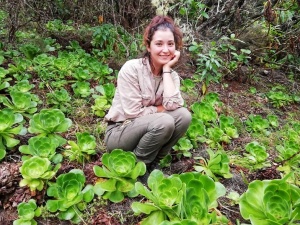Brilhante, M., Roxo, G., Catarino, S., dos Santos, P., Reyes-Betancort, J.A., Caujapé-Castells, J., Sequeira, M.M., Talhinhas, P. & Romeiras, M.M. (2021) Diversification of Aeonium species across Macaronesian Archipelagos:correlations between genome-size variation and their conservation status.
Frontiers in Ecology and Evolution,
9, 607338. DOI:10.3389/fevo.2021.607338 (IF2021 4,496; Q2 Ecology)
The rich endemic flora of the Macaronesian Islands places these oceanic archipelagos among the top biodiversity hotspots worldwide. The radiations that have determined the evolution of many of these insular lineages resulted in a wealth of endemic species, many of which occur in a wide range of ecological niches, but show small distribution areas in each of them. Aeonium (Crassulaceae) is the most speciose lineage in the Canary Islands (ca. 40 taxa), and as such can be considered a good model system to understand the diversification dynamics of oceanic endemic floras. The present study aims to assess the genome size variation within Aeonium distribution, i.e., the Macaronesian archipelagos of Madeira, Canaries and Cabo Verde, and analyse it together with information on distribution (i.e., geography and conservation status), taxonomy (i.e., sections), morphological traits (i.e., growth-form), geological data (i.e., island's geological age), and environmental variables (i.e., altitude, annual mean temperature, and precipitation). Based on extensive fieldwork, a cytogeographic screening of 24 Aeonium species was performed. The conservation status of these species was assessed based on IUCN criteria. 61% of the taxa were found to be threatened (4% Endangered and 57% Vulnerable). For the first time, the genome size of a comprehensive sample of Aeonium across the Macaronesian archipelagos was estimated, and considerable differences in Cx-values were found, ranging from 0.984 pg (A. dodrantale) to 2.768 pg (A. gorgoneum). An overall positive correlation between genome size and conservation status was found, with the more endangered species having the larger genomes on average. However, only slight relationships were found between genome size, morphological traits, and environmental variables. These results underscore the importance of characterizing the cytogenomic diversity and conservation status of endemic plants found in Macaronesian Islands, providing, therefore, new data to establish conservation priorities.


